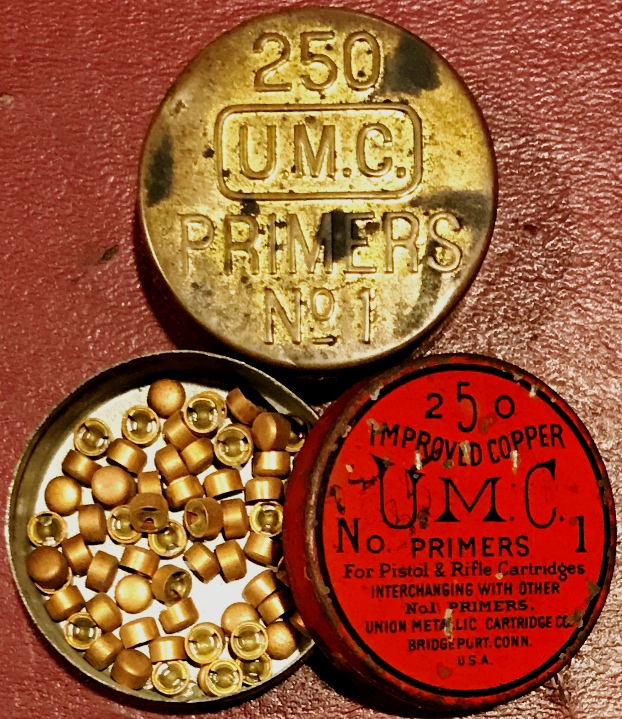|
THE CARTRIDGE COLLECTOR'S EXCHANGE |
||
|
|
Home of the Old Ammo Guy's Virtual
Cartridge Trading Table
Picture Page February 2019
Please note: Unless otherwise indicated, the pictures on this web site are my property, and should not be used by anyone without crediting the source. A UMC box of SPECIAL .32 Ideal cartridges....... I was clueless regarding the origin of the .32 Ideal cartridge until I did some digging after finding the box that is the subject of this month's write-up. A couple of the cartridge reference books indicate the cartridge was introduced in 1903, and I had always assumed it was developed by the Stevens Arms and Tool Company because the cartridge is so often associated with the Stevens Model 44 and 44 1/2 single shot rifles. While trying to pin down the actual date of introduction, I looked through the UMC catalogs in the International Ammunition Association's reference area and found it listed back at least to the July 1st, 1895 catalog. There is a gap in the IAA copies of UMC catalogs (that list metallic cartridges and not just shotgun shells) until the the June 20th, 1890 catalog, which does not include a listing the .32 Ideal. Checking Dan Shuey's W.R.A.Co. Headstamped Cartridges and Their Variations revealed that Winchester first listed the .32 Ideal in 1894. The 'light bulb' moment for me was when I found that Shuey had noted that the Ideal Manufacturing Company designed the .32 Ideal as the "Ideal" cartridge for rechambering shot out and rusted barrels of .32 rimfire and centerfire rifles of the period. This revelation sent me looking for a reprint of an early Ideal handbook that I vaguely recalled having. Finding the Ideal Handbook No 5 reprint in my poorly organized library, I was surprised to discover that it included an illustration and discussion of their 'new' .32 Ideal shell that was being made for them by the Union Metallic Cartridge Company. A description of the shell and it's bullets was followed by a statement of their purpose for having developed the cartridge: to provide 'a desirable central fire inside lubricated cartridge, that the thousands of .32 caliber Short, Long and Extra Long rim-fire rifles that have been shot out or rusted, may now be rebored, rifled and chambered for the Ideal Cartridges, (also 32-20 barrels) thus converting a discarded and useless weapon into an Ideal rifle'. I found no date of publication in the Ideal Handbook No 5, but there was a Marlin advertisement on the inside of the front cover that included illustrations and descriptions of the Marlin Models 1889, 1891 and 1893 rifles, but not the Model 1894. This told me that handbook no 5 was probably published in 1894 or perhaps 1895 at the latest. Next I pulled up the web site of Cornell Publications, the "world's largest old gun catalog & manual reprinter", to see if they had any of the Ideal handbooks and their publication dates. It was no surprise to find they had a long list, beginning with handbooks No 1 and No 2, both published in 1891, through No 41 which was published in 1957. Handbooks No 3 and No 4 were listed as 1893, and No 6 was listed as 1895. Apparently, they were also unable to pin No 5 down to a specific publication date and assigned it a circa 1894 date, perhaps based on the same reasoning as mine.
That all said, the
.32 ideal cartridge was designed in 1893 or 1894 by the Ideal
The Union Metallic Cartridge Company manufactured the primed shells for Ideal, and listed the cartridge in their own catalog perhaps as early as 1894, but certainly by July 1st, 1895. The standard load was 25 grains of black powder and a 150 grain flat nose grooved lead bullet.
The early
box of UMC .32 Ideal cartridges shown above has the small 'SPECIAL' label added to the top
label to
Given that UMC
began selling the .32 Ideal cartridge in 1894, the square corners and edges
of this
box
are a little unexpected. As early as 1883 UMC adopted a round edged box
design that was easier and probably less costly to produce, and the use of
such boxes continued until well
UMC last listed the .32 Ideal cartridge in their 1915-1916 catalog, and probably ended production sometime in that time period. Peters first listed it in their August 1st, 1904 catalog, but by 1917 it was no longer listed. It was probably no longer produced in any significant quantities by any ammunition maker after the commencement of World War 1.
In addition to existing rifles with worn out barrels being rechambered by gunsmiths to use this cartridge, at least two gun companies offered the .32 Ideal as an option for new production rifles. These were Stevens, in their Model 44 and 44 1/2 single shot rifles (as previously mentioned), and the Winchester Repeating Arms Company, in their Model 1885 single shot rifle.
In the interest of determining if these cartridges could be used in a rifle chambered for the standard cartridge, I sent a couple of of the 'special' cartridges from this box
to a customer who owned a Winchester Model 1885 rifle that used the .32 Ideal cartridge and who had bought some of the standard cartridges from me. I had anticipated that the extra length of the bullet would not easily enter the rifled portion of the barrel and would make closing of the action difficult. He reported that the special cartridge chambered "just fine' in his rifle. The photo above shows a special order Winchester Model 1885 single shot rifle that is chambered for the .32 Ideal cartridge. As indicated in the description, the .32 Ideal was a rare chambering for the Model 1885 rifle. .
. . . . . . . ..
. . . . .
The two tins of UMC No 1 primers shown here were the company recommended primers for reloading these UMC .32 Ideal cartridges. However, as primer sizes were standardized among the different American ammunition manufactures, No 1 primers (boxer pattern) by any maker would have been suitable. . . . . . . .
. . . . .Sources:
Background information on the .32 Ideal cartridge, Ideal Hand Book of Useful Information for Shooters No. 5, Ideal Manufacturing Co, New Haven, Connecticut, 1894?, reprinted in 1992 by (George) Hoyem Publications, P.O. Box 4044, Bellingham, WA 98277
W.R.A.Co. Headstamped Cartridges and Their Variations, Daniel L. Shuey, WCF Publications, Inc, 2516 Highcrest Road, Rockford, IL 61108, July 1999 Cornell Publications LLC, https://www.cornellpubs.com Winchester - The Gun That Won The West, Harold F. Williamson, A. S. Barnes & Co, New York Special order Winchester Model 1886 rifle from The Winchester Book, George Madis, Art and Reference House, Brownsboro, TX 75756, 1977 Information on dates the .32 Ideal was listed in catalogs from scanned UMC and Peters cartridge catalogs from the International Ammunition Association reference section, http://www.cartridgecollectors.org/ammunition-catalogs .
.
|

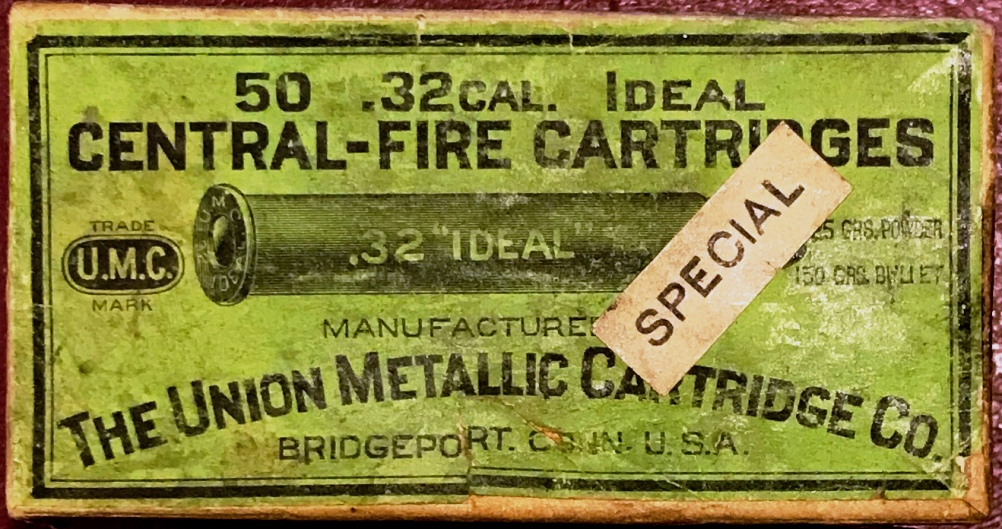 Manufacturing
Company, the New Haven, Connecticut maker of bullet molds and cartridge
loading tools and supplies.
Manufacturing
Company, the New Haven, Connecticut maker of bullet molds and cartridge
loading tools and supplies. 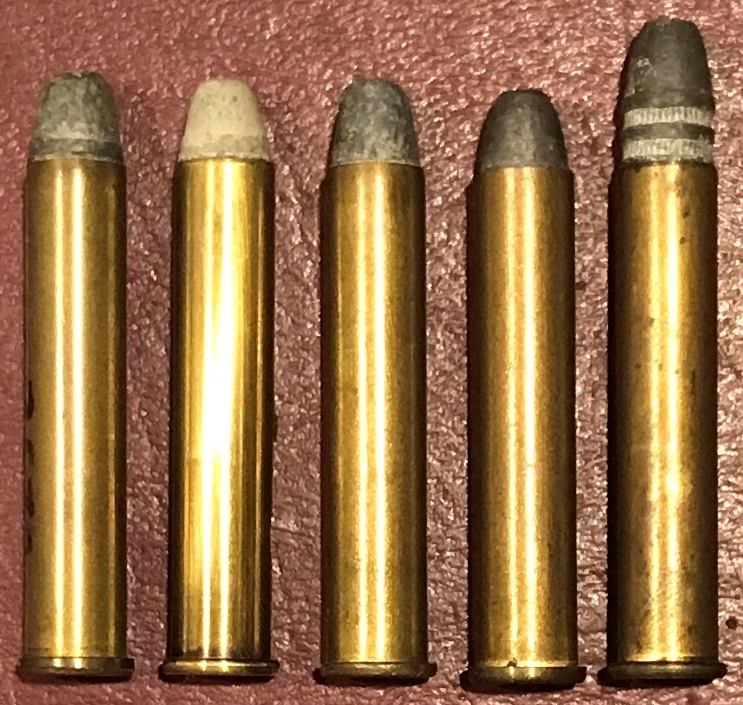 indicate
that the cartridges are a non-standard (or special) load. That the
cartridges are certainly different becomes obvious upon opening the box and
comparing one of the cartridges to a standard load. This is quite evident in
the photo here of one of the
special loads to
indicate
that the cartridges are a non-standard (or special) load. That the
cartridges are certainly different becomes obvious upon opening the box and
comparing one of the cartridges to a standard load. This is quite evident in
the photo here of one of the
special loads to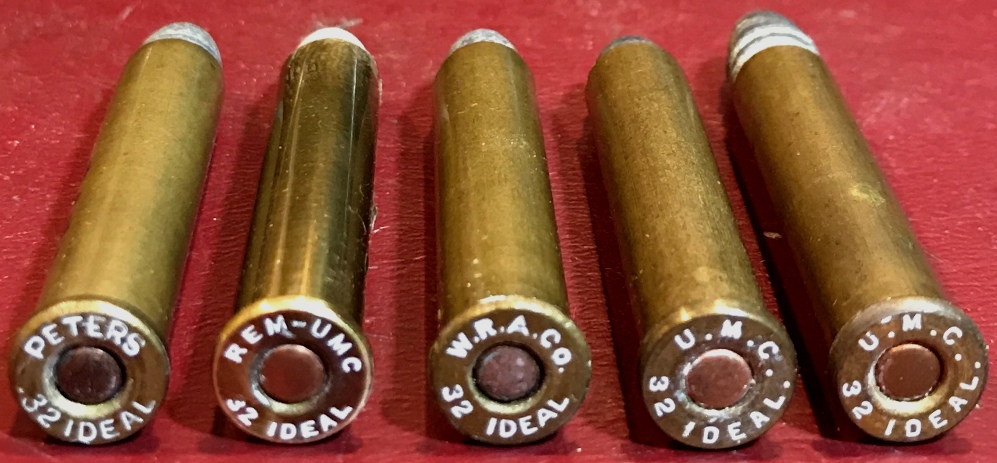 the right of four standard .32 Ideal
cartridges. The headstamps are shown in the second cartridge photo, these
being PETERS, REM-UMC, W.R.A.Co, and U.M.C. for the last two. I
pulled one of these special cartridges and a standard UMC
cartridge apart and weighed the components; the powder
charge of the
special load was approximately 31 grains, or about 6 grains
more than the
standard
charge
of 25 grains. As a result, the bullet can only be partially
seated in the case, resulting in two of the grease grooves extending beyond
the case mouth. Surprisingly, the bullet and empty case of the
the right of four standard .32 Ideal
cartridges. The headstamps are shown in the second cartridge photo, these
being PETERS, REM-UMC, W.R.A.Co, and U.M.C. for the last two. I
pulled one of these special cartridges and a standard UMC
cartridge apart and weighed the components; the powder
charge of the
special load was approximately 31 grains, or about 6 grains
more than the
standard
charge
of 25 grains. As a result, the bullet can only be partially
seated in the case, resulting in two of the grease grooves extending beyond
the case mouth. Surprisingly, the bullet and empty case of the
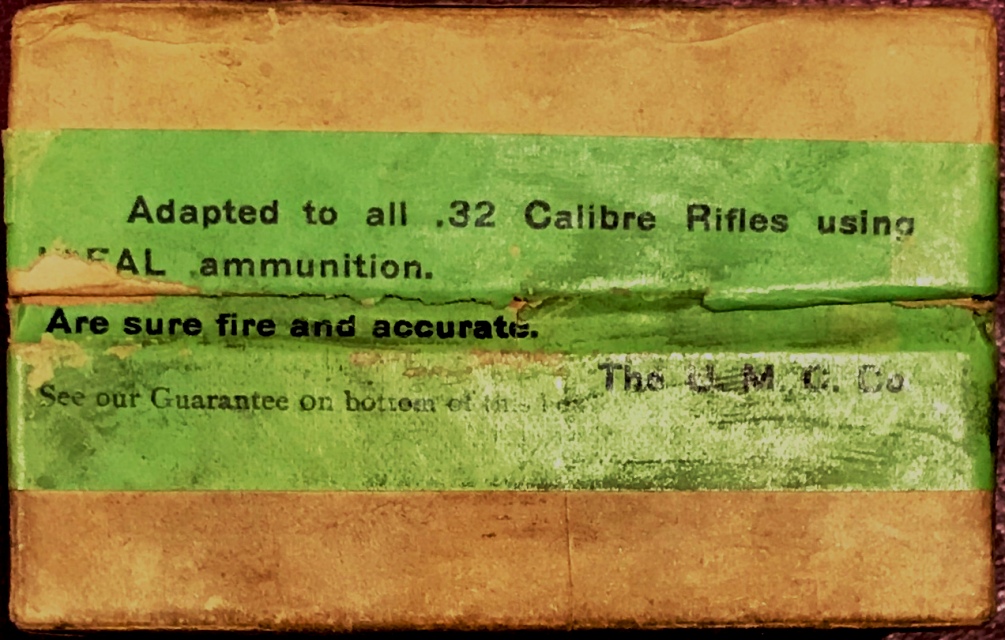 special
load weighed less than those of the standard load by 4 grains and 2
grains, respectively, so the total weights of the two
cartridges were actually
pretty
much
equal. I doubt however that this was intentional.
special
load weighed less than those of the standard load by 4 grains and 2
grains, respectively, so the total weights of the two
cartridges were actually
pretty
much
equal. I doubt however that this was intentional.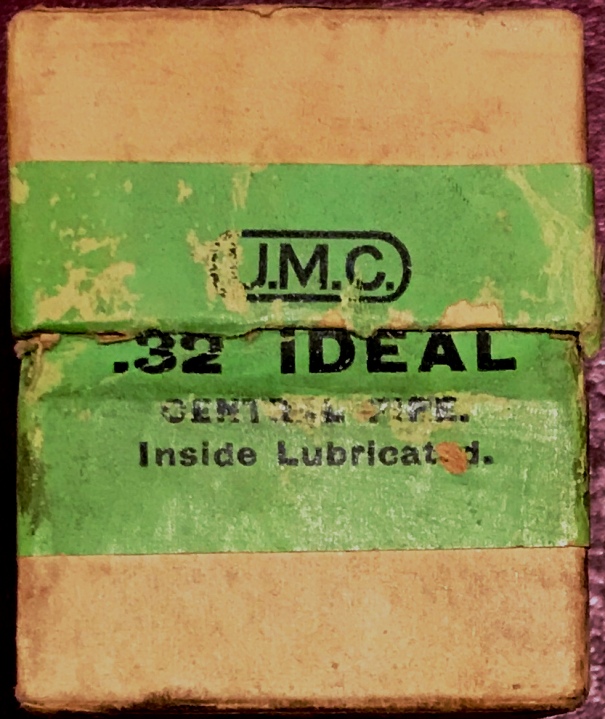 after the merger of Remington Arms and UMC
in 1912. In fact, the rounded edge boxes went out of production around 1920
when one-piece boxes with end flaps replaced the two-piece lift-off-top
boxes.
after the merger of Remington Arms and UMC
in 1912. In fact, the rounded edge boxes went out of production around 1920
when one-piece boxes with end flaps replaced the two-piece lift-off-top
boxes. 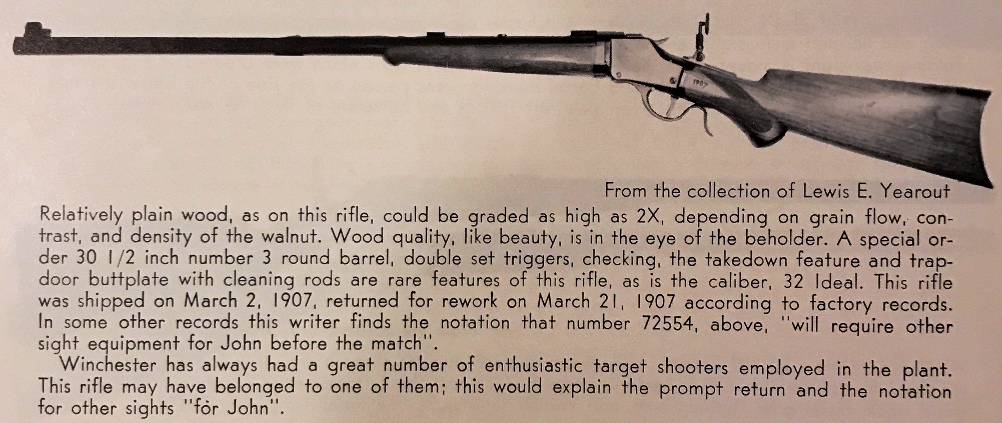
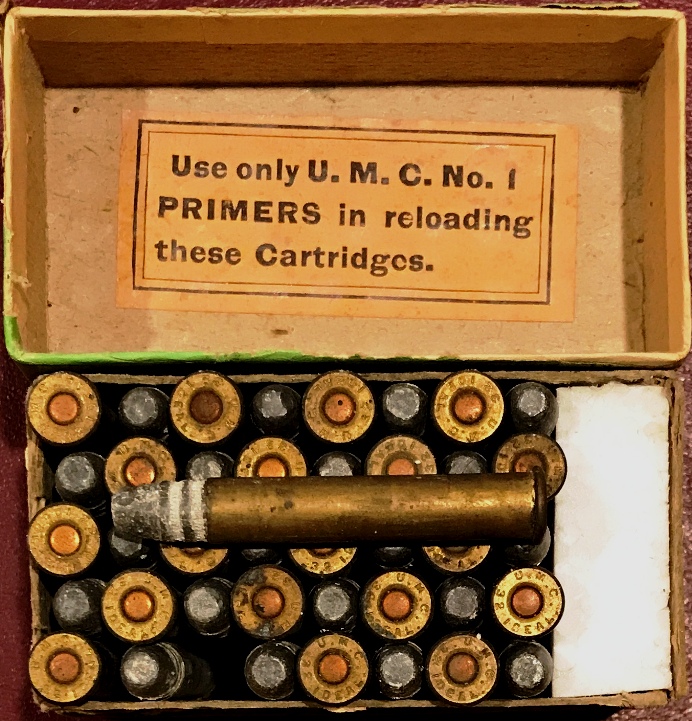 As
is typical for these two piece boxes made by UMC, Winchester and others, a
label was pasted inside of the top or on the outside of the box indicating
at a minimum the correct primer to be used when reloading the cartridge cases,
and sometimes included a list of the recommended brand or brands of powder
to use.
As
is typical for these two piece boxes made by UMC, Winchester and others, a
label was pasted inside of the top or on the outside of the box indicating
at a minimum the correct primer to be used when reloading the cartridge cases,
and sometimes included a list of the recommended brand or brands of powder
to use. 